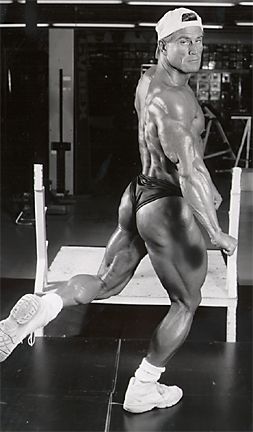

Strength training is the process of exercising with progressively heavier resistance for the purpose of strengthening the musculo-skeletal system. You can shape, decrease, firm up, cut up, and fill out parts of your body on command. Want a flat waist??? Flatten it. Need a butt lift...lift it. You can change everything about how you feel and look with a good training program. Focus on these basics then learn the specific routines, exercises and diets that will help you shape your body the way you want it to look.
Physiologically the positive adaptations and changes that result from regular strength training include:
- Increased
muscle fiber size.
-
Increased muscle contractile strength.
- Increased
tendon tensile strength.
- Increased
bone tensile strength.
- Increased
ligament tensile strength.
- Increased
skin tone
- Sleep and
bowel regulation
These beneficial changes within the musculo-skeletal tissue have a profound influence on our physical capacity, physical appearance, metabolic function, and injury risk.
BODYBUILDING SECRET - The More You Use a Muscle, The More Energy It Burns..Even at Rest!
Muscles
utilize energy to produce movement power, functioning as the engines
of our bodies. Specifically, strength training increases the size and
strength of our muscle fibers, resulting in a greater physical capacity
to perform work. Stronger muscles enable us to lift a heavier weight
one time (muscle strength), and to lift lighter weight more times (muscle
endurance).
Research
indicates that previously untrained men and women gain about 2-4 pounds
of muscle and 20-40 percent more strength after two months of regular
strength exercise. The rate of muscle gain and strength development slows
down after the initial training period.
From that point on the individuals will have to make some intelligent choices on how to cycle their training and increase their intensity and nutrition program. Nutrition is 90% of your success. Training is important and without it no amount of perfect eating-without hard training will make you muscular, but it is the foundation of your success.
BODYBUILDING SECRET - Eating Correctly Is More Important Than Training!
You will have to keep a journal of your eating and training to understand what works for you and what does not. Start with the foundation and advanced programs and diets provided for you in this book and you will do well.
"LOOKING GOOD 101..IT'S A MUSCLE THING."
Our skeletal
muscles have a lot to do with our overall physique. Consequently, strength
training can play a major role in enhancing our body composition and physical
appearance. Consider a 114-pound woman who is 24 percent fat (27 pounds
fat weight, 87 pounds lean weight). If she loses 4 pounds of fat and adds
4 pounds of muscle she will still weigh 114 pounds but will be only 20
percent fat (23 pounds fat weight, 91 pounds lean weight). Although her
body weight remains the same she has less fat and more muscle for a leaner,
firmer, and fitter appearance.
Our physical appearance and physical capacity can be positively influenced by muscle gain or negatively influenced by muscle loss. Unfortunately, unless we perform regular strength exercise, we lose up to one-half pound of muscle every year of life after age 25. Without an appropriate training stimulus, our muscles gradually decrease in size and strength (atrophy). Strength training is therefore important for preventing the muscle loss that normally accompanies the aging process.
Metabolic Function
Muscle is very active tissue with high
energy requirements for maintenance and rebuilding processes. Even when
we are asleep, our skeletal muscles are
responsible for over 25 percent of our calorie use. An increase in muscle
tissue causes a corresponding increase in our metabolic rate, and a decrease
in muscle tissue causes a corresponding decrease in our metabolic rate.
The gradual
loss of muscle tissue means that non-training adults will experience a
2%
percent
reduction in metabolic rate every year of life. This gradual decrease
in metabolism is closely related to the gradual increase in body-fat that
typically accompanies the aging process. While less energy is required
for daily metabolic function, calories that were previously necessary
may end up in fat storage. Although our metabolism eventually slows down
with age, this and other degenerative processes can be markedly delayed
through regular strength training.
Injury Risk
In addition to being the engines of the body, our muscles also serve as shock absorbers and balancing agents. Strong muscles help dissipate the repetitive landing forces experienced in weight-bearing activities such as running and aerobic dance. Balanced muscle development reduces the risk of overuse injuries that result when one muscle group is much stronger than its opposing muscle group.


For example, jogging places
more stress on the posterior leg muscles than the anterior leg muscles,
creating a muscle imbalance that often leads to knee injuries. Similarly,
tight low-back muscles and weak midsection muscles are predisposing factors
for low-back pain. To reduce the risk of unbalanced muscle development,
trainers should address opposing muscle groups such as the gastrocnemius
and anterior tibias muscles of the leg, and quadriceps and hamstrings
muscles of the thigh, the low-back and abdominal muscles of the midsection,
the pectorals, latissimus and deltoid muscles of the torso, the biceps
and triceps muscles of the arm, and the neck flexor and neck extensor
muscles.
A comprehensive strength training program that addresses all of the major
muscle groups may be the most effective means for reducing injury risk.
Although four out of five Americans experience low-back discomfort, 80
percent of low-back problems are muscular in nature and probably are preventable.
The sensible strength training programs that work so well for injury rehabilitation
may be even more useful for injury prevention.
STRENGTH
PRODUCTION
When
a muscle is used to contract, it develops tension and attempts to shorten.
The resulting movement, or lack of movement, depends on the relationship
between muscular forces and resistive forces.
ISOMETRIC CONTRACTION
When the muscular force is equal to the resistive force, there is no movement.
This is known as an isometric contraction and is most representative
of one's actual strength production. For example, if you can hold a maximum
weight of 50 pounds at 90 degrees of elbow flexion your effective isometric
force output is 50 pounds.
CONCENTRIC CONTRACTION
When the muscular force is greater than the resistive force, the muscle shortens, resulting in a concentric contraction. Concentric contractions are not as strong as isometric contractions because internal muscle friction decreases effective concentric force output by about 20 percent. For example, Dan can hold a maximum weight of 50 pounds at 90 degrees of elbow flexion (isometric contraction), but he can lift a maximum weight of only 40 pounds in the biceps curl exercise (concentric contraction). Dan's actual strength production is still 50 pounds, but internal muscle friction subtracts about 20 percent from his effective concentric force output.


